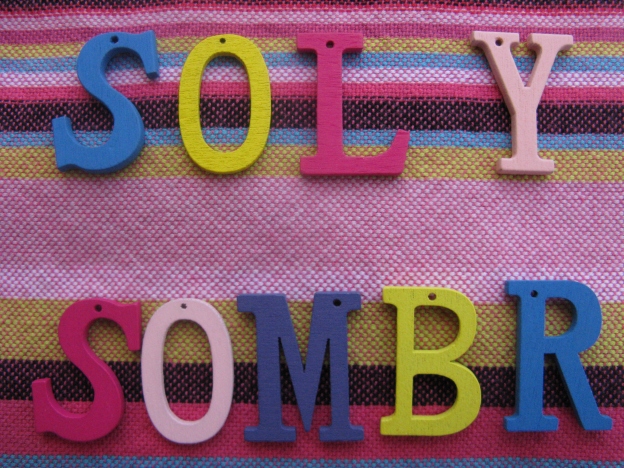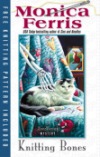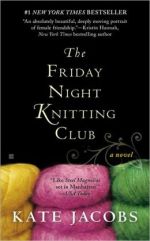Authors: Rangina Hamidi & Mary Littrell
Photographer: Paula Lerner
Publisher: THRUMS Books
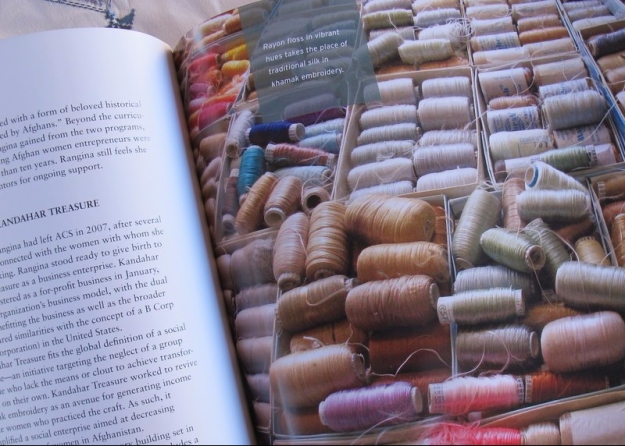 Format & layout:
Format & layout:
254 x 254 mm (10″ x 10″)
Softcover
172 pages
ISBN 9780998452302
Full-colour images with text on a white background
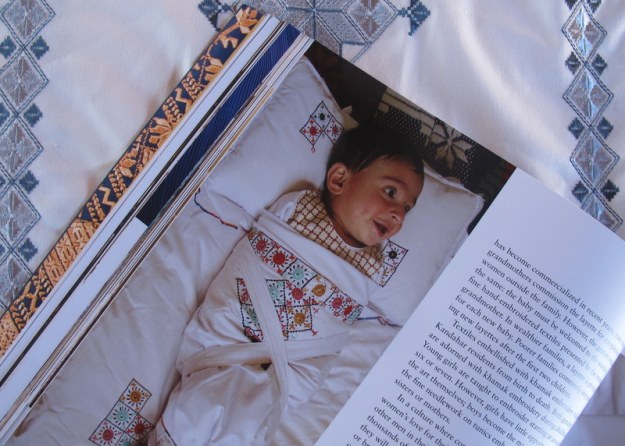 Photos, Illustrations & Diagrams:
Photos, Illustrations & Diagrams:
High-quality full-colour images on every spread depicting Afghan women and children in their cultural and domestic surroundings. Several detail images of embroidery work on garments and household items.
The images are loaded with emotions, bringing to life the environment these women live in. The dust, poverty, confinement and desperation is palpable. But so is the love, care, intimacy and strong bonds between the women and children. The reader is transported to Kandahar just by paging through the images in this book. The relationship between photographer and subject is obvious. Paula was trusted with access to lives, living conditions and relationships that are not usually visible to the outside world, and she trod with sensitivity and compassion. On first glance, I found the photos of obvious poverty and confinement sad but on closer look, I saw joy, pride, and a spirit of determination and resilience in the lives of the women of Kandahar. Paula’s images open a window into a world very few people ever get to see.
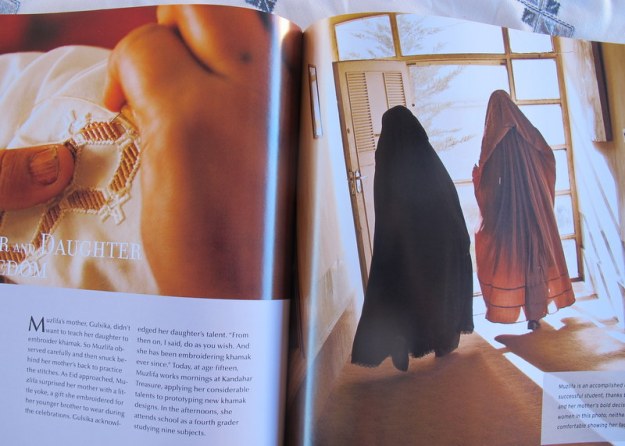 Introduction:
Introduction:
Rangina Hamidi immigrated to the US from Soviet-occupied Afghanistan as a child with her parents. After 9/11 and its aftermath, she decided to return to Kandahar in the south-west of Afghanistan, to help rebuild her former hometown where thousands of women, widowed by years of conflict, struggled to support themselves and their families. She decided to start an entrepreneurial enterprise, using the traditional embroidery of Kandahar, to help the women work within their cultural boundaries, earning a living and finding a degree of self-determination. Thus Kandahar Treasure was born.
Mary Littrel devotes her life to researching textile artisan enterprises and how they can achieve sustainability in the global market. She spent years working in the field across the globe. She is Professor and Department Head Emerita of Design and Merchandising at Colorado State University and serves on the Textile Society of America Board of Directors.
Paula Lerner, who sadly passed away in 2012, was an award-winning photojournalist. She made five photography trips to Afghanistan and won an Emmy award for her work on Behind the Veil, a multi-media feature about the lives of women in Afghanistan. Together with her friend Rangina Hamidi. She endeavoured to showcase Afghan women’s profound struggle, strength and beauty.
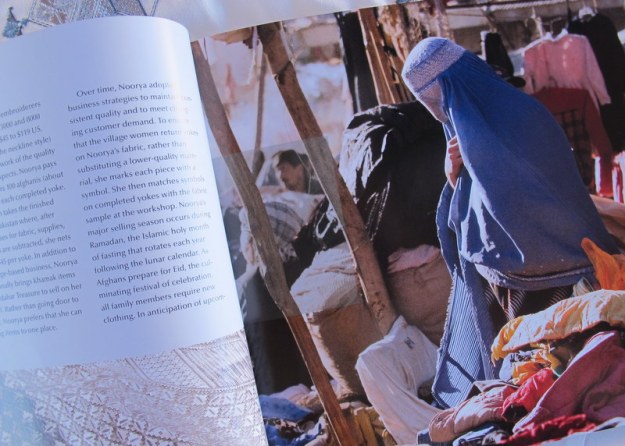 Content:
Content:
The book is divided into eight chapters chronicling the story of the women of Kandahar Treasure. The first three chapters create context, describing the living conditions and societal constraints these women live under – the harsh realities of living in a country where women, in general, have little status, and widows have even less. It goes on to highlight the importance of khamak-embroidered textiles in the lives of the Pashtun people.
The next three chapters tell the story of Kandahar Treasure and the women who are empowered by this enterprise. It tells of Rangina’s s journey into establishing the business and the evolution and growth of Kandahar Treasure as a women’s organisation within a conservative Muslim culture. It also gives context and introduces the techniques of khamak stitching and the revival of this living textile tradition.
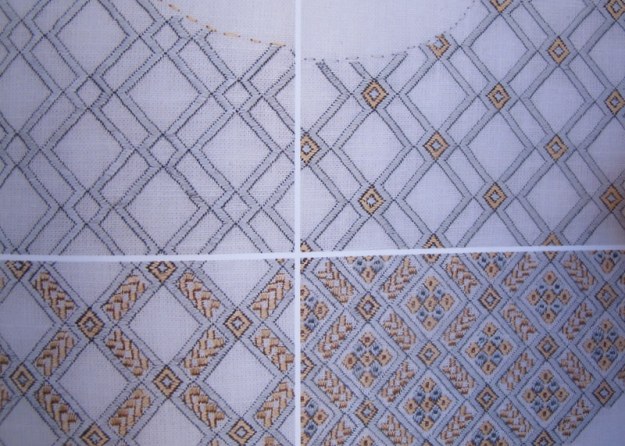 The last two chapters of the book provide an assessment of the challenges, successes and the future of Kandahar Treasure, putting it into a broader perspective and looking at its long-term sustainability.
The last two chapters of the book provide an assessment of the challenges, successes and the future of Kandahar Treasure, putting it into a broader perspective and looking at its long-term sustainability.
Throughout the book and between the chapters there are narratives of real people, the women of Kandahar Treasure. They tell their own stories, describing how their lives have been influenced by war, and how working on a textile revival has given them the power to take control of their lives and those of their children.
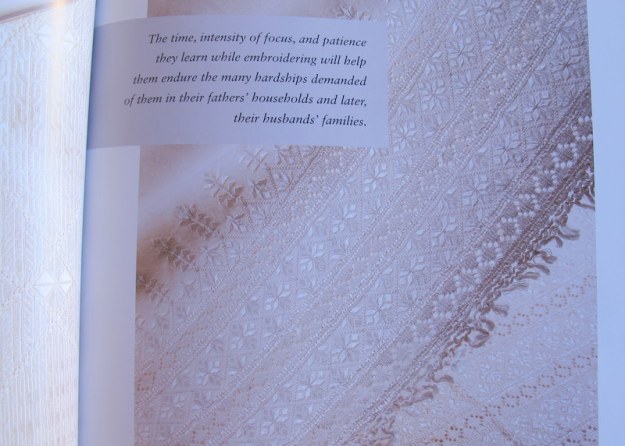 Conclusion – My experience and opinion of the book:
Conclusion – My experience and opinion of the book:
I had the opportunity to visit Afghanistan back in 2006. I spent some time in Kabul and travelled up to Mazar I Sharif. I was looking forward to receiving this book as I thought I had a basic understanding of the situation in Afghanistan, the living conditions and the challenges women and children face. But I was not prepared for the emotions this book stirred in me.
Opening the book for the first time, I almost felt a sense of dread looking at the images of women fully covered by burqas and the children in poverty-stricken surroundings. I looked at the embroidery on the burqas and felt an unease, an inability to admire the fine, highly skilled stitching on this oppressing garment. But as I turned the pages I saw that none of these women and children were alone. They were all in family and friend groups. The sisterhood and friendship bonds were obvious. Then I saw that those women who had their faces exposed, and the children, were all laughing, smiling, looking loved and cared for, and I became intrigued to learn more about the source of their strength and courage.
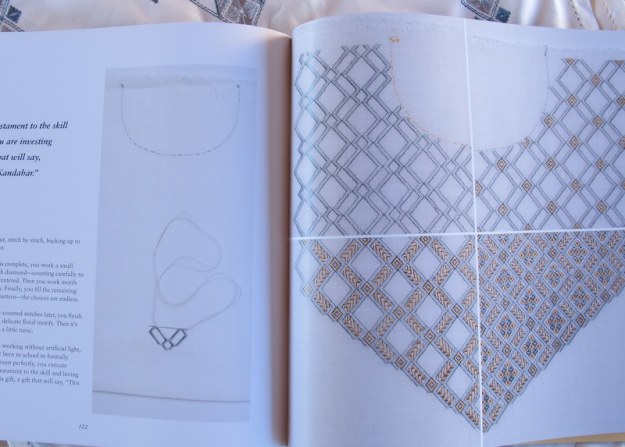 Reading the book opened a new world to me. From the first pages of acknowledgements and introduction of the authors and photographer, right through to the last sentence I was mesmerised by the inner strength and resourcefulness of the women portrayed in this book. Rangina Hamidi is a force of nature. Her philosophy of working within the confines of Pashtun traditions, respecting the order of society, gaining and keeping the trust of the men, elders and other authority figures, ensures not only the safety of the women she works with but ironically enables them to have more freedom and decision-making power in their own lives and those of their families.
Reading the book opened a new world to me. From the first pages of acknowledgements and introduction of the authors and photographer, right through to the last sentence I was mesmerised by the inner strength and resourcefulness of the women portrayed in this book. Rangina Hamidi is a force of nature. Her philosophy of working within the confines of Pashtun traditions, respecting the order of society, gaining and keeping the trust of the men, elders and other authority figures, ensures not only the safety of the women she works with but ironically enables them to have more freedom and decision-making power in their own lives and those of their families.
“Embroidery is the one sphere of women’s lives that men do not control. It’s precision, delicacy, and beauty stand in stark contrast to the imperatives of a typical Afghan woman’s life.”
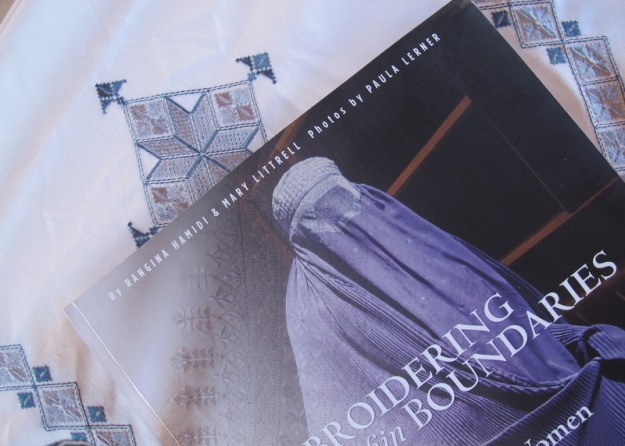 The authors emphasise that Kandahar Treasure is not a charity, an aid organisation, or an NGO. This is a business enterprise. It is based on solid economic principles. Teaching the women to look after themselves financially, to contribute to their households, and to empower themselves by delivering high-quality work, is as important as keeping the Khamak embroidery tradition alive and flourishing.
The authors emphasise that Kandahar Treasure is not a charity, an aid organisation, or an NGO. This is a business enterprise. It is based on solid economic principles. Teaching the women to look after themselves financially, to contribute to their households, and to empower themselves by delivering high-quality work, is as important as keeping the Khamak embroidery tradition alive and flourishing.
This book is a manifestation of Rangina Hamidi’s original vision – A Kandahar Treasure. It shines a light on the region, the tradition, the living conditions, the problems and the victories of the women of Kandahar. It also shines an equally bright light on a unique embroidery tradition and the fine skills of women otherwise hidden from the world.
Paula’s images set the scene and create the atmosphere of the book, but Rangina and Mary’s prose gives context, depth, and character to both the embroiderers and the embroideries of Kandahar.
I wholeheartedly recommend this book to lovers of fine embroidery and textiles, those interested in learning about other cultures and ways of life, and those inspired by stories of endurance, courage, triumph, and hard work.
This is a look-book as well as a read-book. The images are wonderfully evocative but it is only half the story. Sit down and learn from the women of Kandahar. They have much to teach us all.
Buy your copy here.

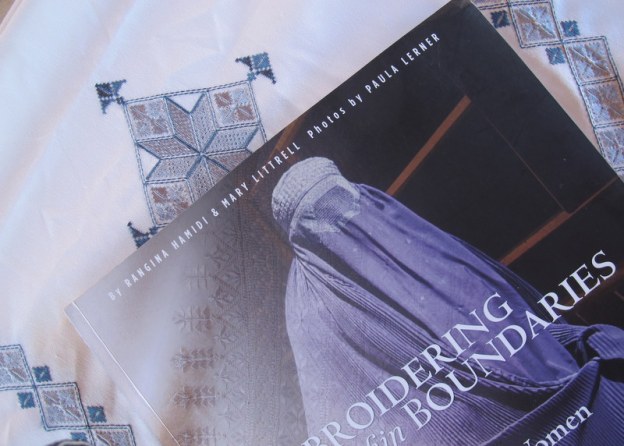

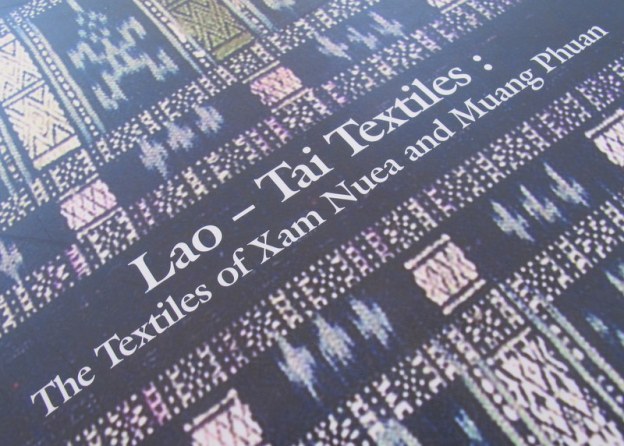
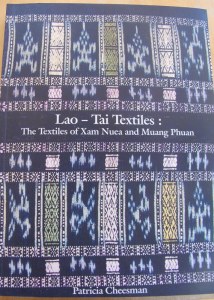 Patricia Cheesman has spent the past 30 years conducting in-depth research on Lao and Thai textiles. She is the author of several books and articles on the subject and has contributed to many international exhibitions.
Patricia Cheesman has spent the past 30 years conducting in-depth research on Lao and Thai textiles. She is the author of several books and articles on the subject and has contributed to many international exhibitions.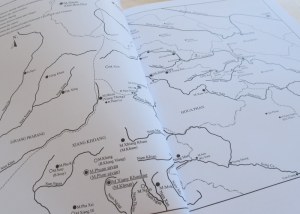 PHOTOS, ILLUSTRATIONS AND DIAGRAMS:
PHOTOS, ILLUSTRATIONS AND DIAGRAMS: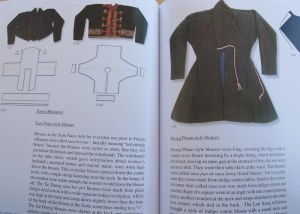 Loads of photographs. A few in black-and-white but mainly colour photographs which include detail shots of the textiles and designs, photos of the local people wearing, making and caring for the textiles, as well as lovely story pictures – photos of the community in which these textiles are made, loved and used.
Loads of photographs. A few in black-and-white but mainly colour photographs which include detail shots of the textiles and designs, photos of the local people wearing, making and caring for the textiles, as well as lovely story pictures – photos of the community in which these textiles are made, loved and used.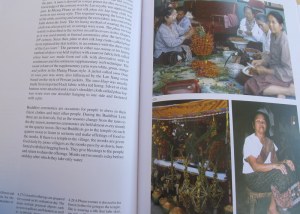 The book starts with the author’s acknowledgements and background notes on how her research was conducted, how she set the parameters for the book, and how the fact that she grew up in Asia and is fluent in the Lao language informed her research. Maps showing the current and historical ‘lay of the land’ further aids the reader to understand the subject matter.
The book starts with the author’s acknowledgements and background notes on how her research was conducted, how she set the parameters for the book, and how the fact that she grew up in Asia and is fluent in the Lao language informed her research. Maps showing the current and historical ‘lay of the land’ further aids the reader to understand the subject matter.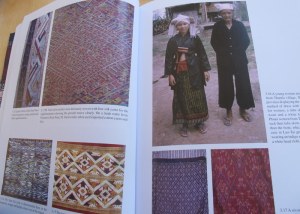 Chapter 4 gives background information about the Lao-Tai culture. The different gender roles, religious ceremonies, wedding and burial ceremonies, as well as the role of local food and architecture, can be seen to influence the different textile designs.
Chapter 4 gives background information about the Lao-Tai culture. The different gender roles, religious ceremonies, wedding and burial ceremonies, as well as the role of local food and architecture, can be seen to influence the different textile designs.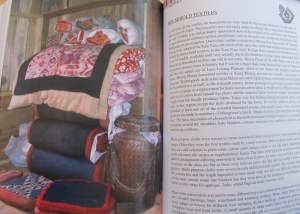 Both the Shamanic and Buddhist religions had a great influence in the design and use of textiles and Chapter 8 goes into great detail describing and illustrating each piece of textile used during religious ceremonies.
Both the Shamanic and Buddhist religions had a great influence in the design and use of textiles and Chapter 8 goes into great detail describing and illustrating each piece of textile used during religious ceremonies.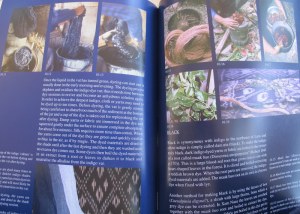 Chapter 10 is all about technique, showing detailed photos of the dyeing and weaving processes used by the artisans. It also shows how both silk and cotton are cultivated and prepared for dyeing and weaving. I love how the background colour of these pages add to the lush feel of the natural dyes.
Chapter 10 is all about technique, showing detailed photos of the dyeing and weaving processes used by the artisans. It also shows how both silk and cotton are cultivated and prepared for dyeing and weaving. I love how the background colour of these pages add to the lush feel of the natural dyes.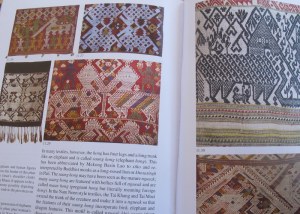 Chapter 11 describes the different symbols, designs and motifs depicted in the textiles. Again beautifully illustrated with detail photographs.
Chapter 11 describes the different symbols, designs and motifs depicted in the textiles. Again beautifully illustrated with detail photographs.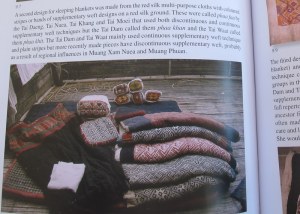 This is a beautiful book with loads of photos. It shows the textiles from a technical point of view as well as a cultural point of view. It puts the textile in the context of its origin. The place, the people and the history. But that is not all. This is not just a look-book – it is a read-book. It is beautiful and you can keep it on your coffee table, but when you go to bed, take it with you and actually read it. It is rich in information and beautifully written. It is obvious that Patricia loves her subject matter. Both the textiles and the community form which it comes.
This is a beautiful book with loads of photos. It shows the textiles from a technical point of view as well as a cultural point of view. It puts the textile in the context of its origin. The place, the people and the history. But that is not all. This is not just a look-book – it is a read-book. It is beautiful and you can keep it on your coffee table, but when you go to bed, take it with you and actually read it. It is rich in information and beautifully written. It is obvious that Patricia loves her subject matter. Both the textiles and the community form which it comes.